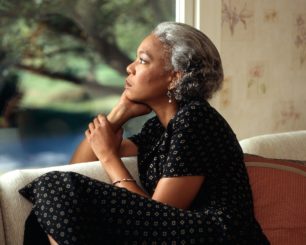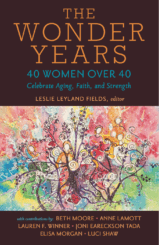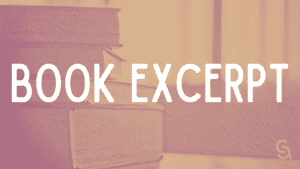
The doors of our refrigerators, once a gallery of finger-painted artwork and soccer snack schedules, are now clean and spare. Minivans have been traded in for something sleeker or have become the property of our teenagers. Hair is graying around the temples—if it’s not completely silver—and the lines around our eyes point to decades of concentration, of laughter, of pain.
We have, for better and worse, figured out the shape and scope of our adult lives. We recognize the trade-offs we have made—career for family, or vice versa. We know who our friends are; our friendships are reliable, time-tested, seasoned.
But that steadiness often makes us feel stuck and we begin to feel a growing desire to bring something new into the world, and that something usually doesn’t require a diaper bag. We get flashes of insight: “Hey, I could do that?” or “I always wanted to . . .” or “Remember how I was so good at . . .” These thoughts energize and sometimes frighten us and we aren’t quite sure which path to take.
A few years ago, I was weaving around the maze of cramped aisles in the shoe section at a department store when my cell phone rang. It was Mary, a friend with whom I’ve shared the deepest parts of my life for more than twenty-five years. Her voice shook; I knew she was in tears. I sat down, awkward and scrunched on a low stool, as other shoppers picked through the boxes of snow boots and sneakers around me. She told me she’d just finished reading Richard Stearns’ The Hole in Our Gospel and, for the first time in her life, she felt compelled to engage with people who are affected by the AIDS pandemic in sub-Saharan Africa.
“I just never knew the scope of it,” she said.
“What are you going to do?” I asked.
“I don’t know,” she said. “Something.”
Since then, she has done something. She’s been to Ethiopia. She’s brought formula and other supplies to orphanages there, educated herself about HIV/AIDS, and addressed local women’s groups about extreme poverty. A few years after I got her call in the shoe section, she and her husband adopted a toddler from Ethiopia, a child who had been orphaned by AIDS. My dear friend’s life changed in midlife. Her realm of influence expanded from that of a woman focused on raising her family in the pleasant Chicago suburbs to advocating for people on the margins, both here and abroad. Her family portrait reflects this change. But how did she decide?
My dear friend’s life changed in midlife. Her realm of influence expanded from that of a woman focused on raising her family in the pleasant Chicago suburbs to advocating for people on the margins, both here and abroad. Her family portrait reflects this change. But how did she decide?
A few years ago, I was in the Bay Area and attended a friend’s church. The priest who gave the homily that day preached on the parable of the ten virgins (Matthew 25:1–13). It was one of those sermons that seemed to be precisely what, as a person edging out of my forties, I needed to hear.
In this parable, Jesus says the kingdom of heaven will be like ten bridesmaids who take lamps to await a bridegroom at night. Five are wise and bring extra oil for their lamps. Five are foolish and do not; their lamps run out while they are waiting. The foolish ones ask the others to borrow a bit of oil, but the wise ones refuse, telling them to go shopping and “buy some for yourselves.” (This hardly seems fair. Were any shops open at that hour?)
But off they go and, unfortunately, while they are away, the bridegroom finally arrives. He welcomes the five wise bridesmaids into the wedding feast and bolts the door behind them. When the “foolish” ones return from their shopping trip, he won’t let them in.
Sitting in the back of that unfamiliar church, I thought about the losses, the moments of scorching insecurity, the slammed doors, and the missed opportunities I’d had during my forties. Sometimes I’ve been like the wise bridesmaids, and sometimes like the foolish ones.
There were times when I wasn’t present with my whole self, but instead was blinded by self-consciousness, anxiety, or the sting of envy. Times when I didn’t even know why I was crying. In what ways had I blinded myself to injustice and the needs of my neighbors? When had I been unprepared? What oil hadn’t I shared with my children? My husband? What opportunities had I missed to serve others in my community and around the world?
In what ways had I blinded myself to injustice and the needs of my neighbors?
The priest told us to cast aside excuses, fears, and regrets and move forward with “gumption and resolve.” Be engaged. Be prepared. Leave regrets behind. This was an exceptionally good message for me at midlife. Now isn’t the time to make excuses. It’s time to move on, with hope.
But how and with what? I found myself back with the questions I asked myself about my friend’s adoption decision.
In his book Beyond Words, Frederick Buechner writes, “Whenever you find tears in your eyes, especially unexpected tears, it is well to pay the closest attention. They are not only telling you something about the secret of who you are, but more often than not God is speaking to you through them of the mystery of where you have come from and is summoning you to where…you should go next.”
The hard truth is that the agitation, restlessness, and lump in your throat can be excruciatingly painful. Those tears aren’t elegant or graceful—when we cry out, we do so in real confusion. We “ugly cry,” desperate for answers from God, and we wish these answers would come clearly, immediately…via email or text message, if you please. We are, hypothetically, willing to do whatever’s required of us, but we can’t stand waiting to know what it is. Making the transition into this new part of life takes time and more patience than we think we can summon.
Christiane Northrup ends her seminal work, The Wisdom of Menopause, with a similar encouragement: “We’re waking up together, you and I…But don’t panic if you feel some pain. Whenever we give birth to anything important, like the new relationship with our souls that is possible at midlife, there are going to be labor pains.”
“There is enormous power here,” Northrup writes. “We’re at a turning point…No one yet suspects how much we can accomplish when we go into our businesses, churches, clubs, and families and, quietly and peacefully, like the stealth missiles we are, set about changing everything for the better.”
We can begin again, in midlife, to stand with oil in our lamps, ready to change our communities and world, ready to participate more fully in what some call the “work of the kingdom.”
And for you and for me, it may all begin when we notice what makes us cry.
Jennifer Grant is the author of six books, including When Did Everybody Else Get So Old? Indignities, Compromises, and the Unexpected Grace of Midlife. She is the mother of four, and wife to one. A former columnist for the Chicago Tribune, she has been a regular contributor to Aleteia For Her and Christianity Today’s Her.meneutics as well as several other publications. She lives in the Chicago suburbs with her husband, children, and two rescue dogs. This essay is taken from The Wonder Years: 40 Women Over 40 on Aging, Faith, Beauty and Strength, edited by Leslie Leyland Fields, and is published here with permission.
is the author of six books, including When Did Everybody Else Get So Old? Indignities, Compromises, and the Unexpected Grace of Midlife. She is the mother of four, and wife to one. A former columnist for the Chicago Tribune, she has been a regular contributor to Aleteia For Her and Christianity Today’s Her.meneutics as well as several other publications. She lives in the Chicago suburbs with her husband, children, and two rescue dogs. This essay is taken from The Wonder Years: 40 Women Over 40 on Aging, Faith, Beauty and Strength, edited by Leslie Leyland Fields, and is published here with permission.


